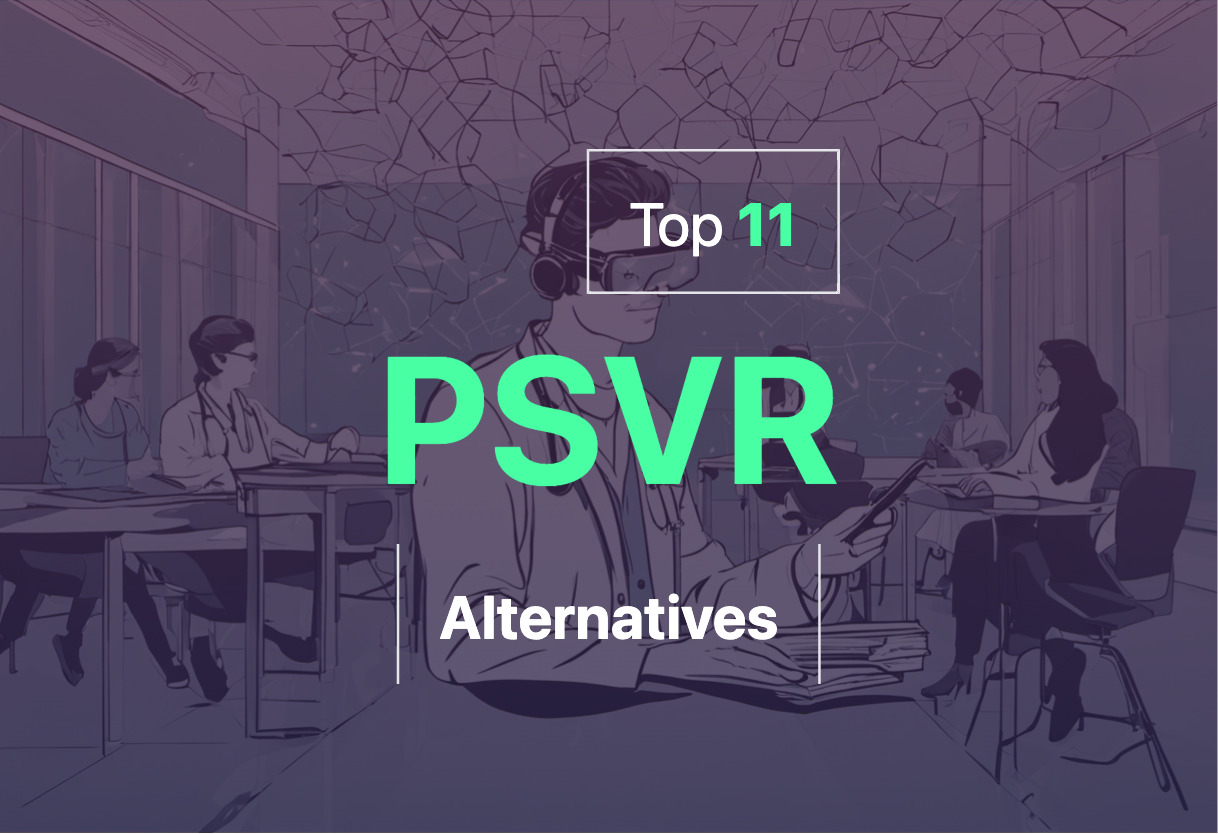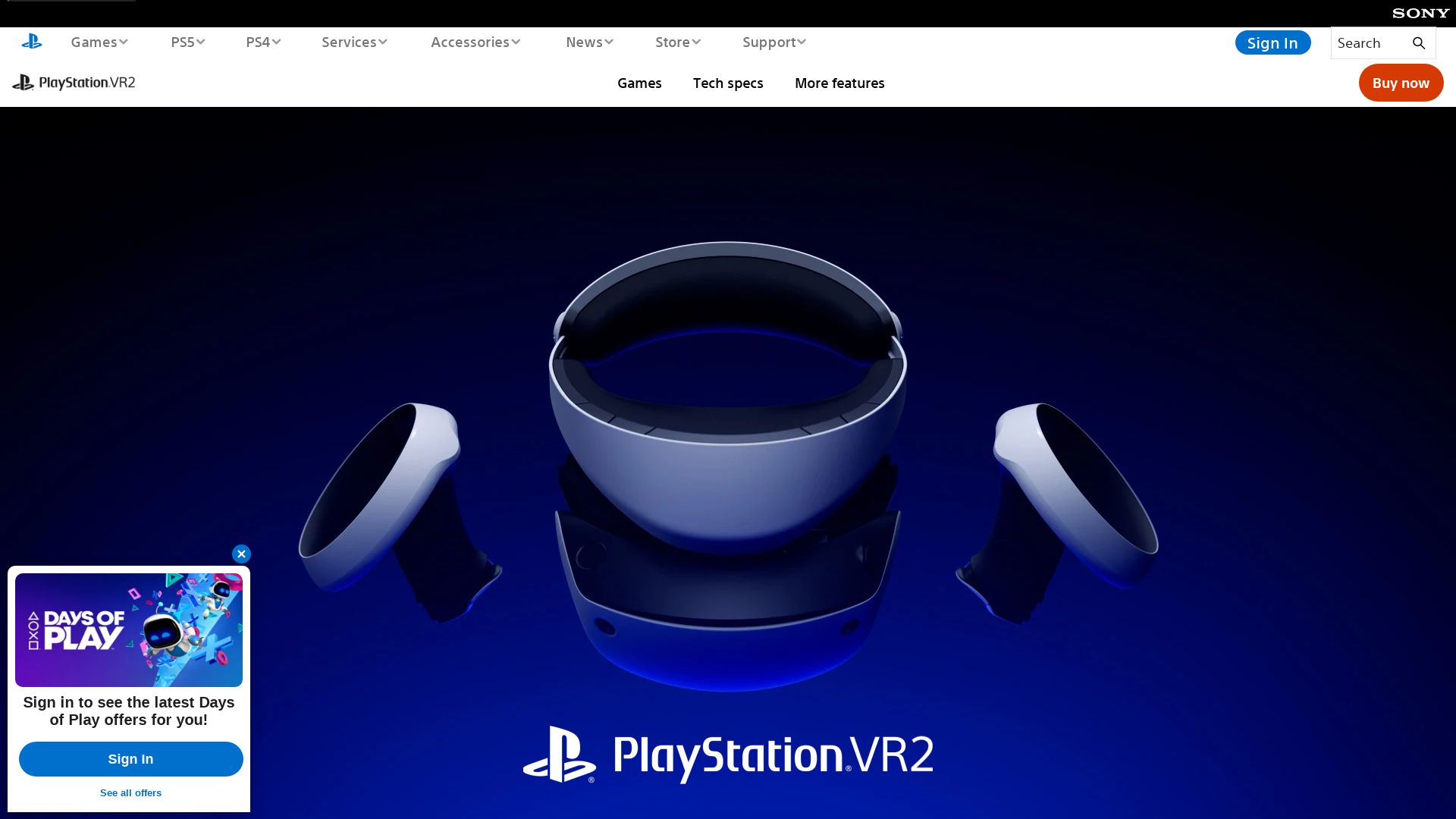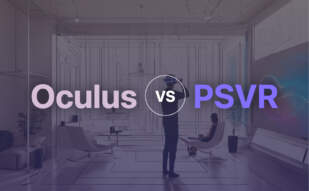PSVR is a virtual reality headset by Sony Interactive Entertainment, part of the PlayStation product family. Offering immersive gaming experiences, it features a 5.7-inch OLED panel and various controller options.

To explore options beyond PSVR, consider PSVR 2, Oculus, Quest 2, Oculus Go, Quest, Oculus 2, SteamVR, Vive, Gear VR, and Meta.
PSVR 2

Enter the world of immersive technology with the improved PSVR 2, the update of Sony’s beloved PlayStation VR headset. With impressive advancements and formidable features over its predecessor, PSVR 2 requires a PlayStation 5 for exclusive and enhanced gaming experiences.
PSVR 2 Top Features
- Improved Resolution: Boasting a stellar upgrade, PSVR 2 flaunts displays of 2,000 x 2,040 per eye, offering vivid 4K visuals for an astounding immersive experience.
- Sense Controllers: Replacing the old Move controllers, the robust Sense controllers bring precision and adaptiveness to your grasp, bolstering your VR journey with engaging haptic feedback.
- Eye Tracking: No more external camera and processor boxes. The PSVR 2 directly plugs into your PlayStation 5 and houses an innovative feature – tracking eye movements inside the headset for increased accuracy.
- Higher Comfort: With adjustable lenses and a sturdy headband, the PSVR 2 balances comfortability and immersiveness impeccably.
- Sound Immersion: Enhancing the VR experience to another level, PSVR 2 comes with earbuds for auditory immersion.
| Feature | Description |
|---|---|
| Field of View | Approx. 110 Degrees |
| Refresh Rate | Up to 120Hz |
| Platform Compatibility | Exclusive to PlayStation 5 |
PSVR 2 Disadvantages
- Limited Game Library: Despite having exclusive titles, the game pool is relatively smaller than competitors like Steam or Meta.
- Pricing: The steep price of $549.99/£529.99 might deter potential users, especially considering the prerequisite PlayStation 5 console.
- Incompatibilities: PSVR 2 is not backward compatible with previous PSVR titles and only supports PlayStation 5.
- Battery Life: Fast drains might interrupt extended use of the VR headset.
PSVR 2 Pricing
The PSVR 2 headset costs $549.99/£529.99, excluding additional costs for accessories like the Sense Controller Charging Dock and Pulse Headset. Remember, a PlayStation 5 (not included) is required to use the PSVR 2.
PSVR 2 Use Cases
Use case 1: Gaming Enthusiasts
PSVR 2 proves to be a compelling choice for gaming enthusiasts. With enhanced graphics, engaging haptic feedback, and unique Sony exclusives, it promises a gaming VR experience like no other.
Use case 2: Tech Aficionados
Tech enthusiasts will appreciate the innovative features and cutting-edge technology from eye-tracking to adaptive controls packed within PSVR 2.
Use case 3: Console VR Users
For users already within Sony’s gaming ecosystem and seeking an immersive console-exclusive VR experience, PSVR 2 is a solid choice, contributing to a seamless gaming environment.
PlayStation VR
Developed by Sony Interactive Entertainment, the PlayStation VR, codenamed Project Morpheus, is a head-mounted display (HMD) that brings the promise of virtual reality (VR) gaming to millions globally since its launch in October 2016.
PlayStation VR Top Features
- 5.7 inch OLED panel with 1080p display resolution providing immersive visual experience
- 9 positional LEDs for 360-degree head movement tracking
- Compatibility with DualShock 4 controller, PlayStation Move controllers, and PlayStation VR Aim controller
- Separate VR and TV picture for competitive or cooperative gameplay
- Impressive selection of VR games and experiences that continue to update
| Feature | Description |
|---|---|
| Backwards compatibility | Works seamlessly with PS4 and PS5 |
| Sound system | Social screen video output to TV and 3D audio effect processing via 3.5mm headphone jack |
| Play space | Optimal for 6-foot by 10-foot space offering great room-scale VR experience |
PlayStation VR Limitations
- Performance significantly impacted by room lighting conditions
- Comparatively poorer tracking performance than high-end counterparts, such as HTC Vive
- Display properties vary between PS4 and PS4 Pro, an aspect more noticeable to tech-savvy users
PlayStation VR Pricing
PlayStation VR continues to be a more affordable VR solution in comparison to high-end VR headsets like HTC Vive and Oculus Rift.
PlayStation VR Use Cases
Use case 1: Social Gaming
The PlayStation VR, with its capability to output picture to both the VR headset and TV simultaneously, takes social gaming to a new level of immersion and competitiveness.
Use case 2: Room-Scale VR
With its optimal performance in a 6-foot by 10-foot play space, PlayStation VR provides an unfettered room-scale VR experience.
Use case 3: Home Entertainment
Offering not just games, PlayStation VR comes with a variety of VR experiences, transforming your living room into a personal entertainment hub.
Meta
Emerging from a conglomerate of titans, Meta, formerly known as Facebook, Inc., embarks into a new frontier – the Metaverse. Founded by Harvard prodigy, Mark Zuckerberg, in 2004, the company has continued innovating, evolving from 2D screens into the realms of augmented and virtual reality.
Meta’s Top Features
- Advanced VR applications like Oculus, satisfying the quest for hyper-realistic virtual worlds.
- Knowledge-sharing and productivity solutions such as Workplace, tailored for expanding businesses.
- Products like Ray-Ban Stories, a leap closer to a confluence of reality and virtuality.
| Product | Functionality |
| Threads | A new way to communicate with close friends via shared status and dedicated inbox. |
| Horizon Worlds | A virtual space enabling users to create their own digital worlds and experiences. |
| Mapillary | An open platform for street-level imagery and map data, enhancing map accuracy and currency. |
Meta’s Limitations
- Controversies, including data breaches and the Cambridge Analytica scandal, have raised concerns about data privacy.
- Meta’s brand image suffered following the reappraisal caused by the costly rebranding process.
- Dependence on ad revenue could limit scope for diversification.
Meta Use Cases
Entertainment
Meta, through its VR subsidiary Oculus, brings a whole new dimension to gaming. Now, users don’t just play the game; they live it.
Work
With Workplace, businesses can streamline their communication and operations for better productivity.
Education
Thanks to Meta’s foray into the metaverse, learning transcends conventional classrooms, making education an immersive experience.
Oculus
Founded by Palmer Luckey, Oculus VR revolutionized the VR industry by launching Oculus Rift, a VR headset line offering a realistic virtual experience at a fraction of traditional costs. The Oculus journey began with the first headset prototype in 2011 and peaked at Oculus Rift S, the latest in the Oculus Rift line, before its discontinuation in April 2021.
Oculus Top Features
- Oculus Rift DK1: Launched in March 2013, it offered a 90 degrees horizontal and 110 degrees vertical stereoscopic 3D view. Screen door effect was significantly reduced.
- Oculus Rift CV1: Unveiled in March 2016, this was the first Oculus headset made for public use; credited for bringing VR into mainstream recognition.
- Crystal Cove: An updated prototype of Oculus Rift CV1, it offered low-persistence of vision.
| Feature | Details |
| Field of View | More than 90 degrees horizontal – double the FOV of preceding VR devices |
| Resolution | 1280×800 total, effectively 640×800 per eye in DK1 |
| Tracking | Three-axis gyros, accelerometers, and magnetometers for absolute head orientation. |
| Software Compatibility | Extensive software library retained compatibility with Oculus Quest. |
Oculus Downsides
- The Oculus Rift line was discontinued in April 2021, limiting its future hardware advancements.
- The Oculus Rift S, intended to replace Oculus Rift CV1, was phased out without a successor.
Oculus Use Cases
Use Case 1: Gaming
Oculus Rift aids gaming enthusiasts in having an immersive experience with its high resolution and wide field views.
Use Case 2: Simulation
Trainings and simulations can be executed realistically with Oculus VR’s near natural views and motion tracking.
Use Case 3: Virtual Tours
Relish immersive virtual tours or real estate walkthroughs with the realistic 3D views of the Oculus VR system.
Quest 2
Brought to life by Reality Labs, a division of Meta Platforms, Quest 2, formerly known as Oculus Quest 2, is a significant step up in the world of VR headsets. Known for its forward-thinking design and impressive specs, it took a major shift, moving away from the PC-based VR strategy, culminating in the Meta transition in 2022.
Quest 2 Best Features
- Display: Touting an RGB LCD display with 1832 x 1920 resolution per eye and refresh rates ranging from 72-120 Hz, the Quest 2 presents an immersive visual experience
- Design: Boasting a lighter weight of 503g, updated Oculus Touch controllers with extended battery life, and a higher refresh rate display, this headset is a combination of comfort and performance.
- Flexibility: Quest 2 can function standalone with the Android-based Quest system software, or it can tap into Oculus Rift-compatible VR software running on a desktop computer.
| Feature | Details |
|---|---|
| Processor | Qualcomm SnapDragon XR2 |
| Online services | Quest Store |
| Sound | 2 built-in speakers, 3.5mm headphone jack |
Quest 2 Limitations
- Despite its impressive features, the battery life of the Quest 2 is rather short, lasting between 2-3 hours between charges.
- This VR headset’s internal storage is not extendable beyond the available 64 GB (discontinued), 128 GB or 256 GB options.
Quest 2 Pricing
The Quest 2’s pricing is varied depending on the storage size. The handy 64GB version costs $299, while the more powerful 256GB version retails for $399.
Quest 2 Use Cases
Use Case 1: Gaming
With an associated Quest Store which boasts dozens of VR games, the Quest 2 takes gaming to a whole new level. The high specifications and advanced controller integration provide a truly immersive gaming experience.
Use Case 2: Online Collaboration
The Meta Quest 2, backed by its robust processor, presents an unparalleled virtual setting for collaboration for professionals and students alike. It bridges the gap between physical distance and interaction through its interactive VR experience.
Use Case 3: Immersive Entertainment
The high-resolution display coupled with robust sound features ensures Quest 2 users a rich, immersive video watching or musical experience, transforming entertainment into an interactive event.
Oculus Go
The Oculus Go is a standalone virtual reality headset developed by Meta Reality Labs, Qualcomm, and Xiaomi. Launched in May 2018, it discontinued in June 2020 due to its groundbreaking design and features for improved immersive virtual reality experiences.
Oculus Go Top Features
- Stand-Alone Experience: Oculus Go distinctively stands out as a standalone headset requiring no PC or smartphone to function, providing a self-contained virtual reality experience powered by the Android mobile operating system.
- Design and Comfort: Weighing slightly over a pound, the Oculus Go is designed for user comfort with a faceplate made of foam and covered with a knit mesh. Spacex head straps ensure the device is securely fixed.
- High-resolution Display: Featuring a fast-switching 5.5-inch LCD display, it delivers a resolution of 1280 × 1440 pixels per eye with a 60 to 72 Hz refresh rate, ensuring a crisp and smooth visual experience.
- Bit-Rich Library: Boasting an impressive library from the Oculus Store and compatibility with most Samsung Gear VR developed software, Oculus Go always has new experiences to offer.
| Features | Beneficial Information |
|---|---|
| 3DOF Tracking | Allows for seated or static-standing activities, enhancing the user’s flexibility in movement. |
| Memory | Incorporates 3GB of LPDDR4 memory together with 32 GB or 64 GB NAND flash storage for storing applications and games. |
| Compatibility | Runs on Android 7.0, providing a wide array of compatible games and applications. |
Oculus Go Downsides
- Non-positional, meaning it only supports 3-degrees-of-freedom (3DOF) tracking, limiting its VR experiences compared to 6DOF devices.
- Short average battery life of 2.5 hours for video and just over two hours for games.
- Product was discontinued in June 2020, limiting its software and hardware support.
Oculus Go Pricing
As of January 2020, the Oculus Go 32GB was priced at US$149 while the Oculus Go 64GB was at US$199, making it an affordable option for VR enthusiasts.
Oculus Go Use Cases
Use Case 1 – Education
The Oculus Go can be utilized in education to create immersive learning experiences, especially in topics requiring spatial understanding such as architecture, engineering, or science.
Use Case 2 – Gaming
Leveraging its wealth of available games and applications, Oculus Go can offer an intriguing range of gaming experiences that transport players straight into the heart of the action.
Use Case 3 – Social Networking
With access to Facebook and other social media platforms, users can enjoy interactive and highly engaging social VR experiences.
Quest
The Quest, a virtual reality headset, is a marvel by Oculus, a company that belongs to Facebook’s Meta. Released on May 21, 2019, it aimed to bring VR into the mainstream, becoming a major player in the hardware arena.
Quest Top Features
- Wireless and standalone design: Freed from the tethers of phones and PCs.
- High-resolution screen: Boasts 1600 x 1440 pixels-per-eye, better than the original Rift’s.
- Powered by Qualcomm Snapdragon XR2 processor.
- Memory options: Comes in 64GB and 128GB storage variants, with a 256GB model for additional cost.
- Complete controller system: Comes with dual hand controllers and supports hand-tracking for certain games.
- Access to robust VR gaming: Supports popular games like Beat Saber, Robo Recall, and The Climb.
- High refresh rate: Supports 120Hz refresh rate mode.
| Competent Battery Life: | The Quest provides between two to three hours of immersive gameplay. |
| Automatic Space Swap: | The ability to remember up to five spaces and automatically switch between them enhances QoL features. |
| PC Tethering: | Using the optional accessory cable for PC tethering enables access to more sophisticated VR experiences. |
Quest Limitations
- Users might find the battery life limiting for extended sessions.
- The reliance on the outdated Qualcomm Snapdragon 835 mobile chipset in the original version could hinder performance.
- Despite supporting hand tracking, it’s not available for all games.
Quest Pricing
The Quest VR headset is priced at $399 for the base model, with the upcoming Meta Quest 3 having a price tag of $499.99 for the 128GB variant. Higher-storage models come at an additional cost.
Quest Use Cases
Use case 1
The Quest, with its vast gaming library, is a prime choice for VR gaming enthusiasts. Its standalone design doesn’t need a gaming PC, making it an accessible choice for users with varied hardware capabilities.
Use case 2
For those who want to make use of hand tracking in games and other apps, the Quest is an excellent choice. This advanced functionality opens up unique interactions in the VR landscape.
Use case 3
The Quest would find use in professional training environments. High-fidelity color Passthrough and innovative machine learning for spatial understanding make it ideal for simulating real-world scenarios.
Oculus 2
Stepping up the VR game, Oculus 2, also known as Quest 2 is a sensation by Meta. A standalone VR headset offering power, precision, and heaps of features, all add up to a dominant market presence.
Oculus 2 Top Features
- Snapdragon XR2 processor for enhanced performance.
- High-resolution 1,920-by-1,832-pixel display per eye, significantly improved from original.
- 120Hz refresh rate, superior to the previous 72Hz.
- Guardian safety system warning users about stepping outside the play area.
- Hand-tracking, Oculus Link & Air Link, Fitness tracking, and more features for a comprehensive VR experience.
| Weight | 1.1 pounds, advancing mobile VR experience |
|---|---|
| Tracking | Improved via four wide-angle cameras & six-degrees-of-freedom |
| Platform | Supports a variety of VR games, experiences, and access to Steam |
Oculus 2 Limitations
- Mandatory Facebook account link, raising privacy issues.
- No storage expansion capability beyond the available options.
- Medium-range battery life of 2-3 hours.
Oculus 2 Pricing
The Oculus 2 starts at a competitive price of $299, subsequently translated to different storage variant prices. The 128GB variant is priced at $499.99 USD offering an affordable alternative in the VR realm.
Oculus 2 Use Cases
Use case 1: Gaming
With its robust processor, high refresh rate, and rich game library, Oculus 2 delivers a top-tier gaming experience for VR enthusiasts.
Use case 2: Fitness
Featuring fitness tracking ability, Oculus 2 serves as a motivational tool for individuals looking to blend fun and fitness.
Use case 3: Social Connectivity
Oculus 2 merges VR tech with Facebook, enabling an immersive social gameplay experience for users, evolving the dynamics of virtual connectivity.
SteamVR

Step into the exhilarating world of SteamVR! Designed by Valve, this powerful runtime turns your PC into a hub for engaging and immersive virtual reality experiences.
SteamVR’s Impressive Features
- Room setup: Customize your very own play area.
- Device Management: Keep your VR gear up-to-date and optimized.
- SteamVR Home: Your launching pad for endless VR adventures.
- SteamVR Collectibles: Earn 3D items based on your in-game activities and achievements.
| SteamVR and HTC Vive | SteamVR plays well with HTC Vive, offering a collective VR experience. |
| PC-Based 3D Environments | Create and explore your own 3D universes. |
| Support for Windows 10 | Get game and have fun on the most popular PC OS. |
SteamVR Downfalls
- Recent compatibility issue reported between SteamVR and Meta Quest 3 when using air link.
- High system requirements including at least Windows 7 SP1, Intel Core i5-4590/AMD FX 8350 equivalent, and Nvidia GeForce GTX 970/AMD Radeon R9 290 equivalent.
- No official support for older operating systems.
Use Cases of SteamVR
Use Case 1 – Gaming
Bring your gaming experience to a whole new level with SteamVR. Embrace the full 360-degree VR environment and maximize your gameplay fun.
Use Case 2 – Fitness
Don’t just play—get active! Strap on your VR headset and dive into an engaging, interactive and virtual workout with SteamVR.
Use Case 3 – Socializing
Keep your social circles vibrant! Connect with friends in distinct virtual environments and share your VR adventures in real-time.
Vive
Vive is a top-notch VR headset engineered by Valve and HTC. This preeminent piece of VR hardware bridges the reality-virtuality gap with unrivaled fidelity, facilitated by a VR-ready PC.
Vive Top Features
- High-resolution screens showcasing spectacular graphics
- Immersive freedom of movement within a 15 x 15-foot room, guided by a precise laser tracking system
- Proprietary motion controllers tailored for an elevated gaming encounters
- Native access to an extensive HTC Vive’s content library
| High-end Upgrade | HTC Vive Pro 2 offers an industry-leading resolution screen |
| Exceptional Tracking | Designed for room-scale tracking, promising a seamless VR experience |
| Substantial Game Library | Inclusive of popular titles likes Half-Life: Alyx and Beat Saber |
Vive Disadvantages
- Requires VR-ready PC, which could add an additional fee of approximately $1,000
- Conventional controllers may feel awkward, recommending Valve Index Controllers for a better experience
- No traditional gamepads included with the Vive
Vive Pricing
The estimated pre-launch price of the Vive is $799. Note that to maximize the potential of Vive, a VR-ready computer, which may cost nearly $1,000, is recommended.
Vive Use Cases
Use case 1: Gaming
For gamers seeking truly immersive experiences, the Vive, coupled with its proprietary motion controllers and extensive gaming library, offers an environment that transcends the normal gaming sphere.
Use case 2: High-definition Virtual Exploration
For virtual explorers, the Vive Pro 2, with its industry-leading high-resolution screen and extensive field of view, acts as a portal to realistically rendered virtual realms.
Use case 3: Professional Training
For professionals in fields like healthcare, aviation and beyond, Vive’s precise room-scale tracking enables accurate simulation for real-world training scenarios.
Gear VR
Presenting a powerful collaboration between Samsung Electronics and Oculus VR, Gear VR – a virtual reality headset, first announced on Sep 3, 2014, and released on Nov 27, 2015. It remained a prominent figure in the VR realm until its discontinuation on Sep 30, 2020.
Top Features of Gear VR
- A field of view controlled by the headset, coupled with a custom IMU for accurate rotational tracking.
- Connectivity via USB-C or micro-USB, transforming your Samsung Galaxy device into the display and processor.
- On-board touchpad and back button, alongside a proximity sensor for intuitive navigation.
- Focus adjustable wheel at the top and volume adjustable via a rocker on the right-hand side.
| Specific Features | Corresponding Effects |
|---|---|
| Compatibility with multiple Samsung Galaxy devices | Flexible usage options across different models |
| Six different editions released with iterative changes and additions | Continuous feature upgrades and improvements over time |
| Three.js JavaScript library to create animated 3D computer graphics | Innovative and immersive browser-based animations without proprietary plugins |
Gear VR Limitations
- Not compatible with Galaxy Note10 and later models.
- No longer supported by Samsung as of Sep 30, 2020 – Users account info and data deleted.
- Gear VR’s XR service terminated.
Gear VR Pricing
As the Gear VR technology and its support were discontinued in 2020, it is currently not available for purchase. However, Oculus still provides continued support for existing users.
Gear VR Use Cases
Use case 1: Mobile VR Gaming
The Gear VR brought an immersive, high-resolution gaming experience right into the hands of gamers, with its Samsung Galaxy Note 4 QHD display enabling high-res rendering in the headset.
Use case 2: Virtual Simulations
With its precision motion-tracking feature, Gear VR became a suitable tool for creating detailed and accurate virtual simulations.
Use case 3: Educational Use
A growing trend in science and medical education saw the use of Gear VR for interactive learning experiences, bringing complex concepts to life with its 3D graphics capabilities.
Grant Sullivan
Content writer @ Aircada and self proclaimed board game strategist by day, AI developer by night.





